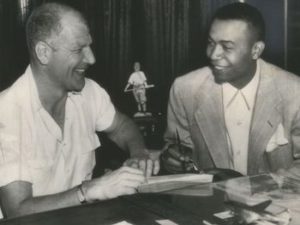As we are in the second half of Black History Month, it is important to recognize the importance of Bill Veeck and Larry Doby in shaping modern baseball history and, more specifically, the Spring Training Cactus League that now brings roughly half of Major League Baseball's teams to Arizona from mid-February through late March.
The other Major League teams train in Florida in the Grapefruit League.
 From African American Registry[/caption]
From African American Registry[/caption]Who are Bill Veeck and Larry Doby?
For those that do not know, they were the 1947 American League equivalent of Branch Rickey and Jackie Robinson.
While Rickey and Robinson get the bulk of the credit for breaking the color barrier in Major League Baseball with the Brooklyn Dodgers, Veeck (also later known as the owner who signed a midget to come to bat for the St. Louis Browns) is the person who ran the Cleveland Indians who brought in Doby to become the first African American to play America's Pastime in the American League.
Doby's first game was on July 5, 1947, and, like Robinson, would go on to have a Hall of Fame career, batting .288 with 273 home runs and 1,099 runs batted in.
While Veeck and Doby helped break the color barrier in Major League Baseball (and Veeck, like Rickey, signed other African players like Satchel Paige and Minnie Minoso,) it is also important to note how breaking that color barrier and integrating the sport led to creating the Cactus League.
While attending spring training in Florida as the owner of the Minor League owner of the Milwaukee Brewers (the major league team would take the name) in 1945 encountered segregation when a White Sheriff and Mayor demanded that he leave blacks only area. According to Veeck, he told both people he would take his team out of the local area if they did not back down. Facing the loss of local revenue, they backed down.
However, this incident, and the fact that Veeck had a ranch in Tucson in the 1940s, convinced him to move his Cleveland Indians to Arizona for spring training in 1947. Veeck was also able to convince New York Giants owner Horace Stoneham (the man who would sign Willie Mays, later move his team to California, and also had a home in Arizona) to move his spring training quarters to Mesa so the Indians could play someone.
The Cactus League was born.
While Arizona also had segregation policies at the time (Doby, Paige, and Minoso had to live apart from their white teammates in Tucson their first full year,) the players were treated to approval and applause by the fans who sat fully integrated at the ballpark during spring training.
With a more friendly environment and nice spring climate, other teams soon flocked to Arizona with the Cubs coming to Arizona in 1951. Now there are 15 teams (including the Dodgers) that play spring ball in Arizona.
Cactus League Baseball, in 2018, generated close to $650 million in revenue for local economies.
All of this is because Bill Veeck would not tolerate Jim Crow intolerance for his players in Florida.
Veeck and Doby are real heroes in the pantheons of racial equality that deserve greater recognition for their contributions to the modern game.
When people go to a spring training game in Phoenix, Tempe, Scottsdale, Mesa, Goodyear, Surprise, Peoria, and Glendale, they should remember why the Cactus League formed and the enlightened reasons the pioneers had for creating it.

No comments:
Post a Comment